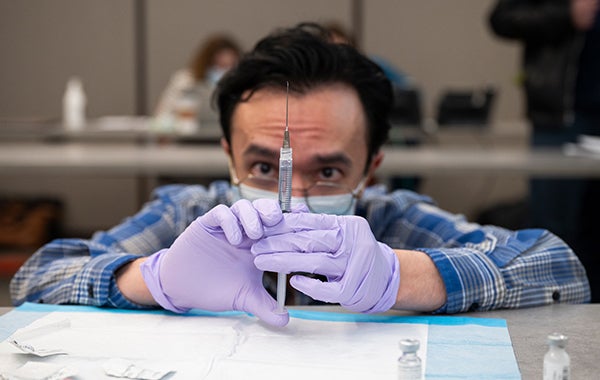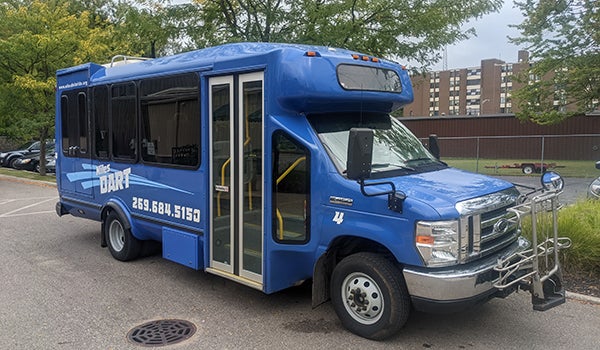Berrien County health officials discuss new vaccine, declining trend in COVID numbers
Published 2:10 pm Thursday, December 17, 2020

- Medical personnel at Spectrum Health Lakeland in St. Joseph began receiving the first dose of Pfizer's coronavirus vaccine Wednesday evening. (Submitted photo)
|
Getting your Trinity Audio player ready...
|
BERRIEN COUNTY — Wednesday evening, a line down a hall at Spectrum Health Lakeland in St. Joseph was filled with medical personnel, some overcome with emotions as they wiped tears from their faces. The employees, many of whom have spent the last nine months caring for patients fighting the novel coronavirus, were among the first in the country to receive the first dose of the COVID-19 vaccine.
During a weekly Facebook Live event Thursday morning, Berrien County Health Department officials Gillian Conrad and Nicki Britten, as well as Spectrum Health Lakeland Chief Strategy Officer Loren Hamel, shared an update about the vaccine and COVID numbers in the county.
“There has been a bit of a downward trend in the number of confirmed cases in the last couple of weeks,” Britten said. “Right now, we’re seeing about 100 new cases per day on average, whereas two weeks ago we were closer to 150, 140 cases per day, with our peak at about 165.”
Britten said that while COVID cases have decreased, so too have the amount of COVID-19 tests being taken, so it is difficult to tell whether the decrease in cases should be attributed to a true decline of transmission, or if the decrease in testing is leading to a decrease in positive results.
Perhaps a better indicator of the virus’ current impact in Berrien County, Britten said the amount of people admitted to the hospital with the virus remains steady.
“We had a peak COVID inpatient census of 85,” Hamel said. “We had a number of days in the mid-70s. We’ve run for a couple of weeks now in the mid- to high-60s. That has been a leveling off trend.”
Thursday, the number of patients admitted to Spectrum Lakeland with COVID-19 was in the mid-50s, Hamel said.
“The staff are working very hard to take care of not only everybody with COVID, but everybody else who’s sick,” he added. “Our facility has been full, but it is very encouraging to see that stable trend, and maybe even some early indications that it’s not going to grow and may even decline a bit.”
For the first time in several weeks, the panelists shared optimism regarding the trajectory of the virus, as medical officials switch from a defensive strategy — treating patients who have already contracted COVID-19 — to a more offensive approach — preventing the spread of the virus with the use of a vaccine.
How does the vaccine work?
Just two days after Pfizer’s COVID-19 vaccine was officially approved, employees at both Spectrum hospitals in Berrien County began receiving the first doses of the vaccine. As excitement — and concern — about the vaccine spread throughout the community, Hamel and the health department worked to address frequently asked questions.
“If I was a singer, I might give you a strain of the Hallelujah Chorus,” Hamel joked Thursday.
He explained that the Pfizer vaccine, which is being manufactured just an hour north of Niles in Portage, Michigan, was created using a method never used before for vaccines.
“The Pfizer vaccine has a tiny snippet of RNA — that’s genetic material — that replicates the RNA in the virus,” he said.
Hamel said unlike vaccines most people are accustomed to, the Pfizer vaccine is not a live virus, nor is it an attenuated virus, meaning that it is not a virus that has been made weaker and then injected into patients.
“When your immune system sees [the vaccine], it says, ‘that doesn’t belong. Let’s make an antibody,’” Hamel said. “The antibody of course is what protects you if you are exposed. It’s an elegant way to stimulate your own immune response in a natural way to get rid of infection, should the virus be transmitted to you.”
Before its approval, the Pfizer vaccine, which is given in two doses about three weeks apart, was studied and tested on 40,000 people. Because the vaccine is not a live virus, those who receive it are unlikely to have many side effects, though the second dose may cause body aches, Hamel said.
“We don’t expect serious long-term side effects because it’s not an infection,” he said.
Who gets the vaccine, and when?
In the first wave of Pfizer vaccines distributed this week, Spectrum Health Lakeland facilities in Niles and St. Joseph received just less than 1,000 doses.
“We’ve set priorities based on where you work and the exposure risk of where you work,” Hamel explained.
He said that because the second vaccine could cause symptoms of fever and body aches, hospital officials have strategically planned cohorts with only a few employees from each department at a time.
“We anticipate being able to get through our highest risk associates within the first several weeks,” he said.
Britten said the health department was not allotted any of the Pfizer vaccine, but hopes to receive the Moderna vaccine, which is anticipated to be approved within the week.
“[Pfizer vaccines] have gone to very few health departments because health departments generally don’t have the freezer capacity for an ultra-cold storage, so the way the state has allocated vaccine is to prioritize the facilities that have the ultra-cold storage to receive the Pfizer vaccine,” she said. “We expect to potentially receive the Moderna vaccine early next week in those first shipments. We have been told that the allocations to the state of Michigan for the Moderna vaccine in the first week that it is available, which again we expect that would be double the amount of the Pfizer vaccine that was allocated to Michigan.”
The highest priority recipients for the Berrien County Health Department include vaccinators, emergency services personnel and residents of long-term care facilities.
Subsequent Berrien County residents are broken into three priority groups, outlined on the health department’s website. After medical personnel and long-term care facilities, the priority will be to vaccinate workers in “essential and critical industries.” This includes K-12 school and childcare staff, and many of the employees who were deemed “essential” and permitted to work during initial stay-home orders that began in March.
After these individuals are vaccinated, people at high-risk for severe COVID-19 illness, as well as individuals 65 years and older, will begin receiving the vaccine.
Though it will take several months and millions of vaccines to reach mass immunity, health department officials said the vaccine is the first step in turning the corner on the virus that has claimed more than 300,000 lives across the U.S.
“I’m sure going to take one when it’s my turn. I hope you will take one when it’s your turn,” Hamel said. “The way to get over this together is to be sure that we all have immunity.”






